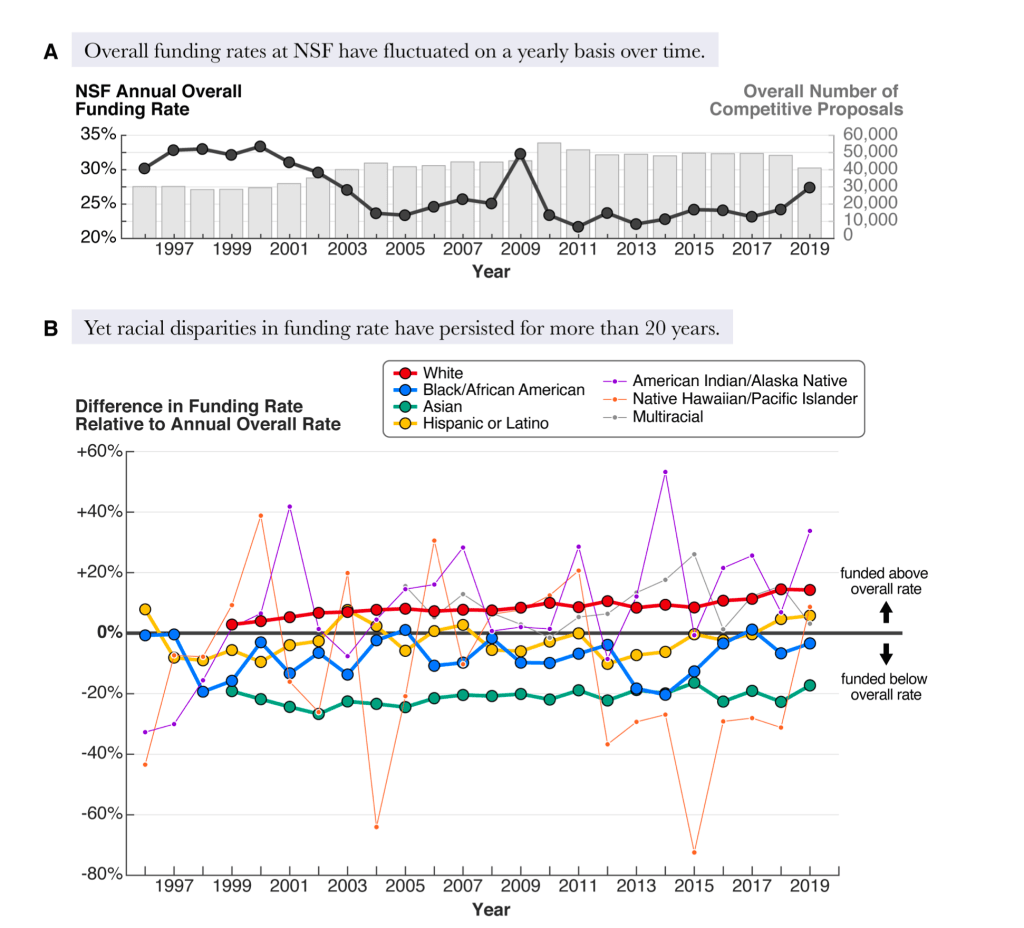Once in a while, I get an email that sounds like this:
Hi everybody I know who is driving distance from campus,
We’re looking to hire an adjunct to teach [something] for us before the semester starts in a few weeks. Ideally this person has a PhD related to this topic and some teaching experience, but if you know of a grad student who is looking to gain experience teaching a course of record and would appreciate a few thousand bucks for a ton of work, please send them to us.
Sincerely, an overburdened departmental chair”
Meanwhile, let’s contrast this with the emails I get for tenure-track faculty positions:
Hi everybody in the entire galaxy,
Our department has opened up a tenure-track search in the area of [specialization]. Please encourage everybody to apply, because we want a really deep pool. That way, we can pick the candidate who has the most publications in the most impressive journals, has the biggest chance of bringing in big grants, and we need a large pool to convince HR that we are following their lightweight compliance process for equitable searches. The search will take several months and the position starts about one year from now. We anticipate spending a good amount of money on startup, there will be reassigned time from teaching for this person to launch well, and we work hard to support this person to make sure they earn tenure. We’re a great place to work, so send us your best!”
Sincerely, an overburdened departmental chair
I think we all appreciate the factors at play in our system that result in this dynamic. When we hire non-tenure-track positions, the process is slapdash, whereas tenure-track searches are whatever the opposite of slapdash is. I think it’s worth thinking about hat this slapdash hiring of non-tenure-track (NTT) faculty means for communities.
Adjuncts* are hired with little to no vetting because departments looking to hire these instructors are often in great need. Considering the workload and compensation associated with these semester-long gigs, when you find someone who is willing to take on a section, then many folks are positioned to be too picky. As far as I know, at most universities, the HR process for NTT faculty is wafer thin. Because it appears to be very common at some places for adjuncts to be hired literally moments before a class starts. Or maybe during the first week of classes.
I think in many departments, chairs are tasked with not only creating a schedule, but also hiring all of the people to teach those courses. There’s no hiring committee. The search process is whatever the chair decides it to be. If there’s anything in the process designed to create a fair and equitable outcome, then in every department that I’m familiar with, that’s entirely at the discretion of the chair who has to fill those slots. But this usually is little or nothing, because there are a lot of slots to fill and this search process is probably about 1% of the workload of the person who is responsible for filing these posts.
I have not (yet) been in this position, but I can’t imagine fitting in a full and proper search for every NTT position that needs to be filled in the midst of all of the other job duties. I think due diligence often consists of a phone call or two to check references to make sure that they’re not horrible, and maybe that’s as good as it gets. I once knew a department chair who joked/not-joked on occasion that hiring NTT faculty is just like hiring day laborers at the Home Depot parking lot (but that the pay and working conditions for the day laborer construction jobs was better).
Is this a problem? Yes, it is. What kind of problems does this cause?
First of all, does the absolute lack of any kind of fair hiring process for NTT instructors mean that you might be increasing the fraction of bad teachers? I don’t think so. I think you’re just as (and perhaps more) likely to bring bad teachers on board when you have a huge process of hiring a professor into a permanent position. Most of contingent faculty that I interact with are passionate about teaching and put a ton of effort and concern into their course. Are NTT faculty phoning it in? I would say that’s a bigger problem with tenured faculty. At least NTT faculty know that they’re being paid (albeit poorly) to teach, whereas tenured faculty might be under the impression that teaching is not necessarily the most important part of our jobs, and behave accordingly. While some NTT faculty are duds, let’s be honest here and recognize that there may well be a higher fraction of duds among the tenure-track and tenured professoriate. Even if you wanted to argue that the lack of a formal process results in more faculty who aren’t good at teaching, I don’t think that’s the biggest problem we have.
So, then, what’s my problem with the process if it doesn’t result in the hiring of bad teachers? Gosh, it’s hard to know know where to start.
While our institutions are exploiting NTT labor to some extent (and that extent varies greatly among institutions), we still are hiring for professional positions and there should be a transparent and equitable process. Think about all of the time and trouble that gets involved into hiring undergraduates for REU positions. Big applicants, statements, letters of reference, a committee. All for a position that pays a few thousand dollars over the summer and then ends. The amount of money for NTT positions is not smaller and all of those concerns about equity, justice, and representation matter. If the opportunity to become an instructor of record is one of the major stepping stones to becoming a professor (and in many places, it is), then how come the process providing access to such an opportunity is so darn inequitable?
I don’t know about your university, but at mine there is a sizable community of NTT faculty who are very important on our campus. Not only do they do so much teaching, they contribute in a lot of other ways (even if their employment contracts do not expect such a a contribution). They serve on our academic senate and help make big decisions about the institution. They help run our student research conference, and are advisors to student clubs, and so much more. (Not all NTT instructors have this level of engagement, but it’s been several times where I’ve worked with someone for months only to discover that they’re not tenure-track, and that they’re doing this stuff even though they don’t have to, but only because they want to.) There are many folks who are making a career out of this role. The people who evolve into this position come at it sideways, usually by getting hired by a departmental chair in a slapdash manner, and then they stick with it over the years.
I think it’s a problem that we have parallel professional pathways for university faculty, with one pathway getting more support, scrutiny, and respect. It’s been a while since I’ve written about how tenure-track faculty are essentially parasites of non-tenure-track faculty, but that situation still is exploitative, even if our universities have been working in earnest to professionalize what it means to be NTT faculty.
Perhaps one of the reasons that faculty and other people in universities aren’t investing enough into NTT faculty is that there’s such little care or concern invested when we recruit people into these roles? Everybody deserves respect and professional support, and perhaps we might begin this process as we should proceed: by putting thought and concern into who gets hired.
I honestly don’t know how to operationalize this idea of conducting a transparent and equitable process for hiring adjunct faculty, and if I were in the position where I was expected to do this, I would be asking, “with what kind of support?” Because we only are creating the academic calendar a few months in advance of when these job opportunities arise. And sometimes because funding is short, we can’t float sections we want to, and sometimes because of demand, some get added at the last minute. The HR and faculty affairs offices wouldn’t have the staff to handle this, and are we asking people to sit on more committees? What does this look like? It sounds like a disaster.
But what we have right now is a disaster, of a different kind, that we’ve just grown to live with. I don’t know what to do with it, and the lack of professional support for NTT faculty is a downright epidemic and the slapdash hiring procedures is just one small consequence of a much bigger problem.
Final note: this post isn’t about anything specific going on at my institution or at any other institution. It was triggered by one of those emails that I got this morning, but those emails are a steady trickle near as we prepare for a new semester. It’s not about you, it’s not about me, except for the fact that it is about everybody and you and me are part of everybody.
* a short note on nomenclature: “Adjunct” can mean a lot of different things. What are the differences among contingent faculty, adjunct faculty, lecturer, non-tenure-track instructor, and other terms of art? There are a lot of subtle differences, and some of these differences vary depending on the institutional context. (For example, in the California State University system, all faculty who are not tenure-line faculty are “lecturers,” that’s the terminology built into the collective bargaining agreement.) “Contingent” simply means that you’re hired at will and don’t have a long-term contract. This gets complex because some non-tenure-track faculty are more contingent than others, depending on policies and guidelines for employment in your university. (For example, in the CSU, the CBA provides for entitlement for NTT faculty who have been on the job for a little while. It’s not exactly tenure, and not a guarantee of future work, but it’s makes it harder to give those teaching assignments to anybody else.) “Adjunct” can be interpreted as a label that a person isn’t a part of the regular faculty, but they’re just a temporary add-on. So this term, when applied to folks who are a well engaged with the campus, isn’t quite appropriate and can be othering.







